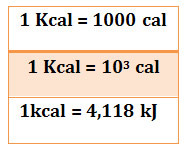With the special week of campaign to combat obesity, developed by Ministry of Health in several schools across the country, with the theme: Prevention of obesity in childhood and adolescence, the topic of the moment is to lose weight in a healthy way. And a common concern is the amount of calories that should be ingested daily so that there is no “weight” increase. But what is a calorie?

One way to measure the calorie of food is by placing a sample of it in a device called calorimeter, which measures the amount of heat released when burning this sample. Thus, the result obtained is given in units of calories or lime.

For example, burning a full 1 liter of gasoline can release about 7 750 000 calories. Thus, calorie is a quantity often used in food, but it can also be used for other processes in which there is heat exchange.
However, as can be seen in this case of gasoline, the calorie is a very small unit, which generally provides very large values. Therefore, the unit that is most suitable is the kilocalorieor kcal.

On food labels and on medical diets, it is customary to quote the term "calorie" when I actually wanted to say “kilocalorie”. To cite an example, it is said that a glass of soda has 200 calories, when in fact it has 200,000 calories or 200 kcal.
To end this confusion, food labels are correctly bringing the energy content of food into kcal or kJ. The kilocalorie is also often referred to as Nutritional Calorie - Lime (with a capital letter), but this unit is not part of the IS, it is only used by some health professionals and can generate a lot of confusion.
By Jennifer Fogaça
Graduated in Chemistry
Source: Brazil School - https://brasilescola.uol.com.br/saude-na-escola/calorias-ou-quilocalorias.htm

